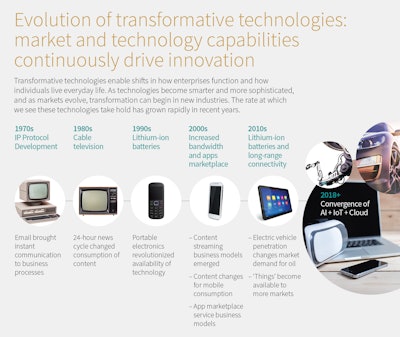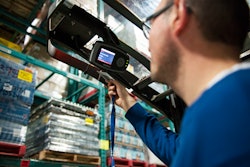
Engineering and technology are forever intertwined. By definition, engineering is the application of knowledge in order to design, build and maintain technologies; and technology is the body of knowledge, systems, processes and artifacts that results from engineering. In this article, we will explore the latest “transformative” technologies and how they impact engineering as a discipline, and how engineering has impacted these technologies.
Recently, IHS Markit identified eight transformative technologies in its report, “8 in 2018: The Top Transformative Technologies to Watch This Year,” that have the potential to impact the world around us in ways never before seen. These technologies are:
- Artificial Intelligence
- Internet of Things (IoT)
- Cloud
- Connectivity
- Blockchain
- Computer Vision
- Ubiquitous Video
- Robots & Drones
To better understand the opportunities and impacts of these transformative technologies, it is critical to understand two things. First, each of these technologies is developing at a rapid pace. And second, that the rate of innovation related to these technologies is accelerating even faster by the fact that they are converging and becoming more interconnected. For example, while AI, IoT, machine vision, robotics, and the cloud are not necessarily new technologies, they are coming together in new and powerful ways to fundamentally change businesses, fuel innovation and disrupt industries—creating both threats and opportunities.
Transformative Technologies Drive (and are driven by) Transformative Engineering
For the better part of the last five decades, engineering has both enabled and benefited from digitization. This “digital disruption” has fueled new transformative technologies that drive paradigm shifts across multiple disciplines and across multiple industries. “It changes the way we think about and design equipment, the way we use equipment, and the benefit that we’re able to get from that equipment, no matter where the engineer sits in the product lifecycle,” says Bill Morelli, senior research director at IHS Markit. “Whether you’re trying to design the next-generation product, or a plant engineer trying to make sure that your production line stays up and running as efficiently as possible, or a field engineer troubleshooting equipment using drones to reduce risk of diagnosing problems in hard to reach places, there are implications for transformative technologies in all aspects of engineering.”
All of these transformative technologies have seen significant development and evolution over the past few years, and that the pace of innovation is only increasing. In fact, what we are now seeing is that innovation actually accelerates as these transformative technology trends start to converge. The synergies between the different technology trends can drive exponential rather than linear change.
Convergence of Transformative Technologies Accelerates Change
These eight technologies are not developing in a vacuum, but rather evolving and becoming more interconnected. As each evolves, as new capabilities emerge, they start working together more and more. And the more they work together, innovation accelerates. As different transformative technologies come together, impact goes from linear to exponential.
Connectivity
Connectivity has been a fundamental enabler of digitization in consumer, commercial and industrial markets for more than 20 years, leveraging a diverse range of wired and wireless technologies. Connectivity refers to the ability to link and communicate with other people, devices, computer systems, software or the internet. This includes both wired and wireless technologies utilizing point-to-point, broadcast and mesh topologies, among others.
Most engineers today have at least a working knowledge of connectivity. “Connectivity has become part and parcel of what engineers need to understand in discrete and process manufacturing and field equipment,” states Morelli. “Connectivity has become a fundamental building block of design and manufacturing. As soon as you connect a device, you dramatically increase the capability and the ability to connect to other devices and/or the internet—it opens the door to a lot of different possibilities.”
However, Morelli adds that “connectivity in and of itself isn’t necessarily a robust solution. In some ways, connectivity can be limiting in that it tends to focus more on a point-to-point solution. Where you have points and multipoints, you quickly evolve to a stage where you’re drowning in data.”
Internet of Things (IoT)
The Internet of Things (IoT) is an extension of connectivity. IHS Markit has identified four stages of IoT adoption and implementation:
- Connect: embedding connectivity and processing capabilities into devices;
- Collect: adding sensors and storage that enables devices to gather data on their surrounding environment;
- Compute: processing and analyzing large amounts of data generated by IoT devices;
- Create: monetizing the IoT or creating unique solutions through access to transformational data.
It is not just the embedded connectivity in a lot of devices, some of which have historically been connected, but the addition of embedded processing capabilities and sensors that have many industries realizing significant improvements in efficiency and productivity.
“Even if you have limited processing to manage the connectivity, let’s put some level of intelligence into sensor X so that it knows what the different readings mean—what environment it’s operating in, what’s a critical reading, and what’s a non-critical reading,” explains Morelli. “If there’s a variation between X and Y, it’s not necessarily going to raise a flag, but as soon as it goes over Y, then raise an alert.”
But now the amount of data starts to escalate. A new transformative technology is needed to handle vast amounts of data. And advanced analytics become necessary to parse through that volume of data to separate the wheat from the chaff, and handle data from other transformative technologies (such as machine vision, covered later in this article).
Cloud
As IoT has matured, and implementations have become increasingly sophisticated, cloud storage and analytics are now a critical enabler for scaling IoT solutions. Cloud computing offers widespread access to shared pools of configurable resources—such as computer networks, servers, storage, applications and services—which can be quickly and dynamically provisioned involving little to no management effort, often over the internet.
“Cloud is synonymous with ‘server somewhere,’” according to Morelli. “Server somewhere other than here allows me to access a database somewhere other than here.”
The Cloud gives engineers the ability to collect and store data, whether it’s for a short amount of time to do immediate analytics, or for a longer amount of time to build a profile of, for example, a production facility in order to identify areas where you could increase efficiency, or optimize performance.
Cloud now becomes a very important part of the story. But if you’re collecting critical bits of information from hundreds, then thousands, then hundreds of thousands of sensors, you can quickly start drowning in data and it becomes harder and harder to see the correlations.
Artificial Intelligence (AI)
With IoT starting to scale, companies are now shifting focus to how they can manage and utilize all of the data they are collecting. Dealing with millions or billions of data points exacerbates the big data problem. Deep learning, machine learning and artificial intelligence are fast becoming essential tools for the engineer.
AI refers to the body of science, algorithms and machines able to perform some version of learning and independent problem solving, relying on sufficiently advanced software and hardware components. Within the AI field of study are other sub-branches of computer science, including machine learning, neural networks and deep learning, among others.
These can be incredibly powerful tools, not only for doing analytics on large data sets, but also to drive out insights and new ways of looking at the problem, because you’re really applying true artificial intelligence to it.
Machine learning is the first step, but then it starts being able to make correlations on its own and starts to see things the engineer may not be able to see, because there’s just too much data to wade through.
Returning to the sensor example, Morelli notes that “this is where machine-learning, deep-learning, neural networks - the technologies we broadly call AI - become really important because you’re able to start analyzing the data, looking for patterns among a lot of disparate data sets. You’re able to then, when you really reach full-blown AI, proactively identify things that you haven’t necessarily asked it to look for, and offer suggestions.”
Robots & Drones
Robots and Drones are autonomous or semi-autonomous machines that are capable of completing complex, often repetitive actions. Robots may be fixed or mobile but are typically land-based, while drones are commonly viewed as aerial and include fixed-wing, rotor-based, airships and balloons.
Robotics have transformed manufacturing and are comparatively more mature in application and development than drones and are used extensively in manufacturing and commercial operations. In the short term, robots will primarily help humans work more effectively; in the long term, robots will become sufficiently skilled and affordable enough to replace humans in many tasks. Already, professional service robots are utilized by early-adopter industries including agriculture, logistics, medical and healthcare, and domestic help.
AI is crucial to the next step in the evolution of drones and their broader adoption by more industries, to address key requirements such as collision avoidance—which is where AI will equip drones to make effective decisions regardless of circumstance. As an example, the latest development in visual mapping and navigation technology for drones includes use of a laser or camera alongside state-of-the-art electronic components to help drones successfully carry out their mission. To date, enterprises are overhauling their logistics systems by incorporating drones in any number of ways, but AI is providing the longer-range control that allows drones to be moved outside a plant or factory for deployment in the real world, such as what Amazon is doing with drones in delivering products to customers through its Amazon Prime Air service.
Computer Vision (including Machine Vision)
Computer vision is the application of technology to extract information from digital images and videos, with the goal of automating tasks that human eyes do today. Specific tasks that are necessary include image acquisition, processing, analyzing and understanding, to allow for decisions/actions to be taken by the system, device or robot. Machine vision, traditionally found in industrial manufacturing, is generally considered to be a sub-set of computer vision and is also referred to as embedded vision.
The increasing importance of computer vision is directly tied to the mega-trend of digitization that has been playing out in the industrial, enterprise and consumer segments over the past 20 years. The proliferation of image sensors, as well as improvements in image processing and analysis, have enabled a broad range of applications and use-cases including industrial robots, drone applications, intelligent transportation systems, high-quality surveillance, medical applications, and automotive safety.
Computer-vision and machine-vision go hand-in-hand with robots and drones. Robots and drones are only functional to the extent that they’re aware of the surroundings. Their functionality increases exponentially if they have a solid machine-vision and/or computer-vision component where they are able to be aware of their surroundings, and adjust their behavior and actions on that basis.
Ubiquitous Video
Ubiquitous Video refers to the ability to capture, create, consume and distribute video content almost anywhere. The explosive growth of video services has been driven by multiple factors, including the high penetration of camera-enabled mobile phones and commoditization, which have enabled displays of various sizes and shapes to be placed in almost any location with a range of wired and wireless connectivity options.
For engineers, ubiquitous video provides the ability to consume video anywhere, anytime, on almost any device, as well as the ability to capture video from anywhere on almost any device. “It’s that proliferation of screens and lenses that are able to capture and display video that plays into what we’re talking about, to some extent, with robots and drones,” says Morelli. “It plays into solutions that we’re talking about with computer and machine-vision. Connectivity obviously is the underlying technology that is making a lot of ubiquitous video possible.”
Further, Morelli adds, “A picture is worth a thousand words—there’s a lot of truth to that, and being able to show, in real time, a video of an event, whether it’s a leak at a plant, or a piece of equipment that’s malfunctioning, or a screen that someone’s looking at that you need to be able to understand exactly what the read-out looks like so you can give them the best solution for how to handle maintenance.”
“In commercial and enterprise applications a few years back, the trend was BYOD, or Bring Your Own Device, where company-issued smartphones were being replaced by personal smartphones, for which the companies reimbursed the costs. That move is now proliferating in industry, as well. It’s very much the same, BYOD, and people have their own smartphones, their own tablets that they’re using for diagnostics, that they’re using to talk to the equipment. You’ve got equipment that’s able to communicate via Bluetooth with machinery in the factory.”
Future Transformative Technologies Impacting Engineers—Blockchain?
Looking forward, there are transformative technologies like blockchain that may end up playing a larger role in the engineering discipline. Blockchain is a distributed digital ledger technology utilizing cryptography and timestamps to provide a permanent record of various types of transactions and interaction. Blockchain is the underlying technology enabling Bitcoin but may be used for a wide range of applications, including engineering and supply chain.
One potential application is for traceability of electronic components and parts in the supply chain; for example, to help prevent counterfeit parts by ensuring an authentic part is being used and warranty assured because blockchain is underlying the part registry.
“It’s like a digital fingerprint for a physical or virtual object,” states Morelli. “What makes it so secure is it’s not being stored in one database that could be hacked or tampered with. The reason they call it a distributed ledger technology is it’s stored in a bunch of places across the internet.”
While these may work well in theory, there are real concerns with how efficient this approach would be. Specific issues around latency, massive power use and data volumes are just some of the challenges.
What’s Next?
It’s difficult to say. The pace of innovation will continue to accelerate and transformative technologies will continue to fundamentally shift how enterprises function. Some of these technologies will continue to evolve and grow—such as artificial intelligence. The jury is still out on others, such as blockchain, as to how and if they will impact engineering in the future. What is certain is that engineering as a discipline will continue to be a driving force in the future of transformative technologies.



















